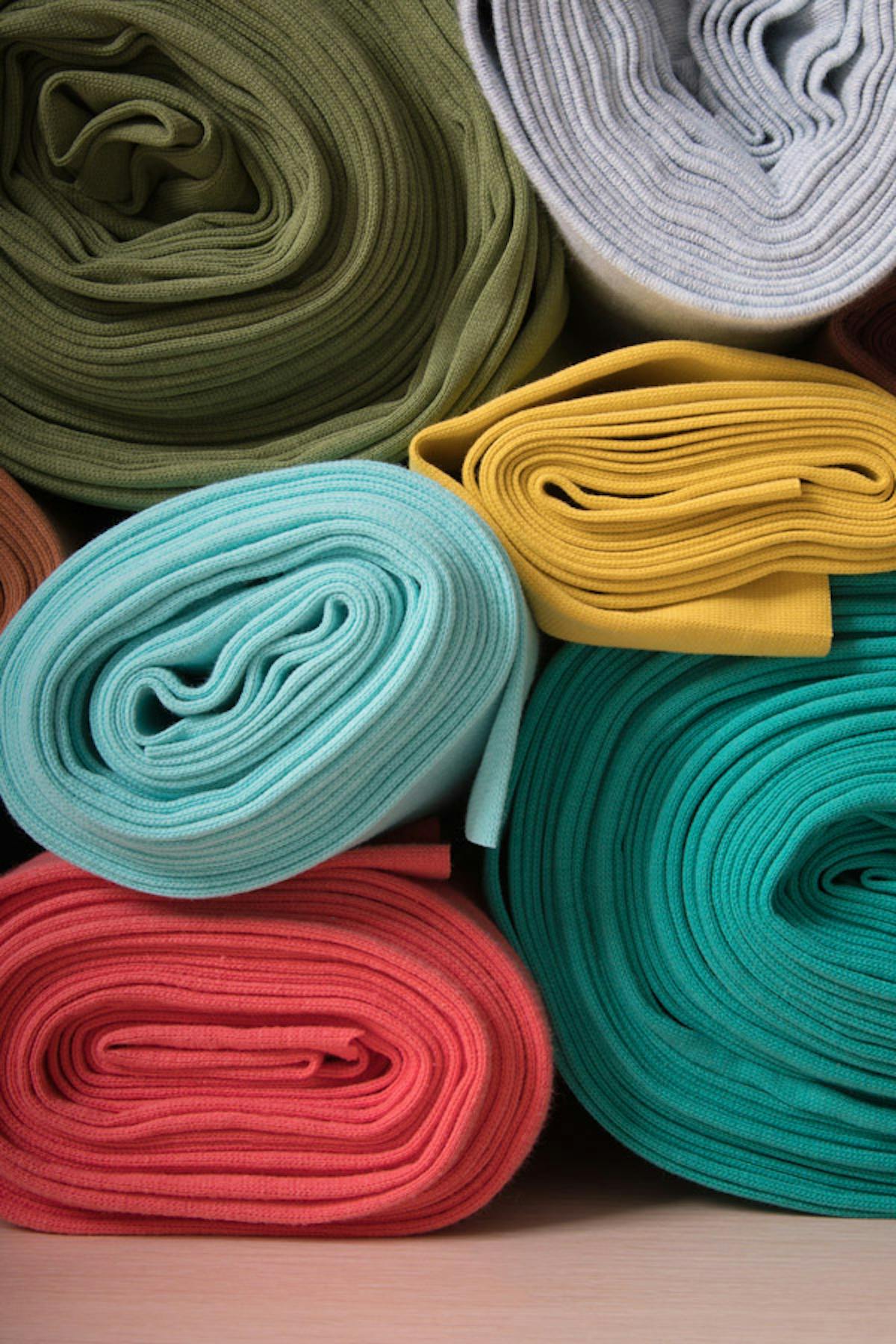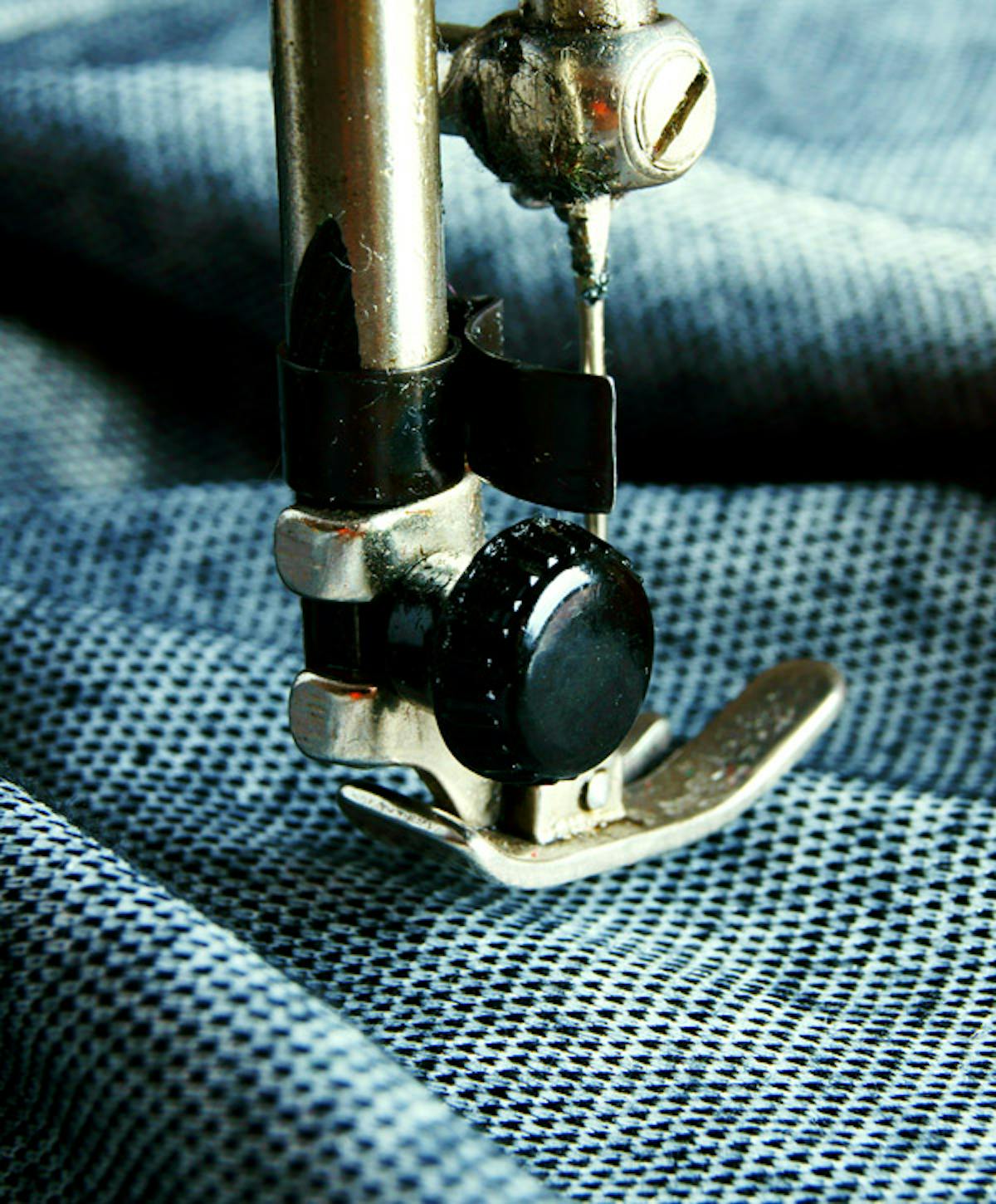Ponte, jersey, rib, and fleece are all popular knit fabrics celebrated for their impressive stretch. Knit fabrics like these eliminate the need for zips, buttons, or other fastenings, when sewing as their natural flexibility allows them to easily stretch over the body, providing exceptional comfort.
While knit fabrics are an excellent choice for your next sewing project, their stretchiness requires a specialized sewing approach to maintain their flexibility. Whether you're new to working with knit fabrics or seeking new finishing techniques, our guide below will help you find the perfect stitch for your project.

What is Knit Fabric?
Knit is a type of fabric made with large industrial knitting machines that use lots of smaller needles to interlock (loop) the yarn together. In this context, we are not referring to the chunky, homemade knits we all know and love, but instead are talking about knitted fabrics sold in lengths, like jersey, sweatshirting, ponte, and rib.
The industrial knitting machines perform the same action as hand knitting, only on a much bigger scale and using much finer yarns. The end results of this process are fabrics that have a tight knit and can be cut out and sewn together without unraveling.
These knit fabrics are comfortable, stretchy, and easy to look after. They are used for anything from t-shirts and sweats, to slinky fitted dresses, and can be made from a variety of fibers – natural or synthetic. They are perfect for babies, children, and adults, making knit a fabric used by the whole family.

Why Can’t I Use A Regular Straight Stitch With Knit Fabric?
A straight stitch works wonderfully for woven fabrics that do not have much movement across the grain, but for something stretchy like a knit fabric, it will interfere with this stretch. The stitch makes a straight row of evenly spaced stitches in a single direction while keeping the tension of the thread perfectly taut. It will provide a neat finish, but one with little give or elasticity.
A standard straight stitch will quickly pucker, snap, and lose its shape if stretched with the knit. To get extra movement from your stitches, look for one that has more elasticity, such as a zigzag or faux overlock seam. With the needle alternating its placement each time, the zigzag stitch has more room to stretch with the fabric.

10 Tips for Sewing Knit Fabric on a Sewing Machine
Most domestic sewing machines have at least a couple of stitch options that will work with knit fabrics. Your machine manual should guide you to the best stitches for your particular sewing machine, but a few of our favorites are:
- Choose the Right Stitch: Most domestic sewing machines offer multiple stitch options for knit fabrics. Zigzag stitch is a go-to for stretchy seams, allowing you to adjust the size of the zigzags to suit your project.
- Experiment with a Faux Overlock Stitch: If you want a serged finish without a serger, try the faux overlock stitch. It's perfect for finishing raw edges and gives a professional look to your hems.
- Invest in a Twin Needle: A twin needle is a worthwhile investment for those who sew knits regularly. It creates two parallel lines on the top and a zigzag on the underside, mimicking the look of a coverstitch.
- Use a Triple Straight Stitch for Strength: If your machine has a triple straight stitch, it’s ideal for knit fabrics. This stitch is particularly strong and works great for hems if you prefer a clean, straight finish over zigzags.
- Use a Walking Foot: A walking foot can help feed the fabric evenly through your machine, preventing stretching or bunching as you sew. This is especially useful for more delicate knit fabrics.
- Select the Right Needle: Always use a ballpoint or stretch needle when sewing knits. These needles have rounded tips that gently push the fibers aside rather than piercing them, reducing the risk of snags or holes.
- Test on Scrap Fabric: Before sewing your actual project, test your chosen stitch on a scrap piece of the same knit fabric. This allows you to fine-tune the stitch length, width, and tension for the best results.
- Avoid Stretching the Fabric: Let the feed dogs pull the fabric through the machine, and avoid pulling or stretching it as you sew. Stretching the fabric can lead to wavy seams or distorted shapes.
- Stabilize Hems with Stay Tape: For a clean, non-stretched hem, consider using stay tape or a narrow strip of fusible interfacing along the edge before hemming. This helps keep the fabric from stretching out of shape.
- Finish Seams with a Stretchy Binding: To keep seams neat and prevent them from rolling, consider finishing them with a stretchy binding. It adds a professional touch and keeps the garment comfortable and durable.

10 Tips for Hand Sewing Knit Fabric
Sometimes a hand-sewn hem is just what a garment needs. Hand sewing on a stretchy knit might seem tricky. However, it is mostly just about choosing the correct stitch to use. We have put together a few tips to help you get the job done.
- Use a Catch Stitch: Ideal for hemming knit fabrics, the catch stitch is barely noticeable on the front side and features a narrow zigzag on the underside, providing a secure and flexible hem.
- Choose a Matching Thread: Opt for a fine thread that matches the color of your fabric to make the hem less visible from the front and achieve a more professional finish.
- Avoid Tight Stitches: Keep your stitches slightly slack to allow the fabric to stretch without puckering. Tight stitches can restrict the fabric’s natural movement and cause uneven hems.
- Use a Fabric Marker for Precision: Mark your hemline with a fabric marker or chalk before sewing. This ensures accuracy and helps maintain a straight hem, especially on stretchy fabrics.
- Pin or Baste Before Sewing: Secure your hem with pins or a temporary basting stitch before you start hand sewing. This will help keep the fabric in place and make the hand sewing process smoother.
- Pre-Wash Fabric: Before sewing, wash and dry your knit fabric to prevent any shrinking or distortion after the garment is completed.
- Press Your Hem: Gently press the hem before sewing to create a clear fold line. This makes hand sewing easier and helps in achieving a straight and even hem.
- Use a Needle with a Sharp Point: A sharp needle will glide through the knit fabric more easily, reducing the chances of snags and uneven stitching.
- Test Stitch on a Scrap: Before working on your actual project, test your stitch on a scrap piece of knit fabric to ensure that it stretches well and looks clean.
- Finish Edges with a Zigzag Stitch: If you’re hemming raw edges by hand, consider using a small zigzag stitch to finish the edges and prevent fraying before hemming.
What are your must-do's when sewing with knit fabric? Let us know on Instagram, Facebook, or Twitter!













